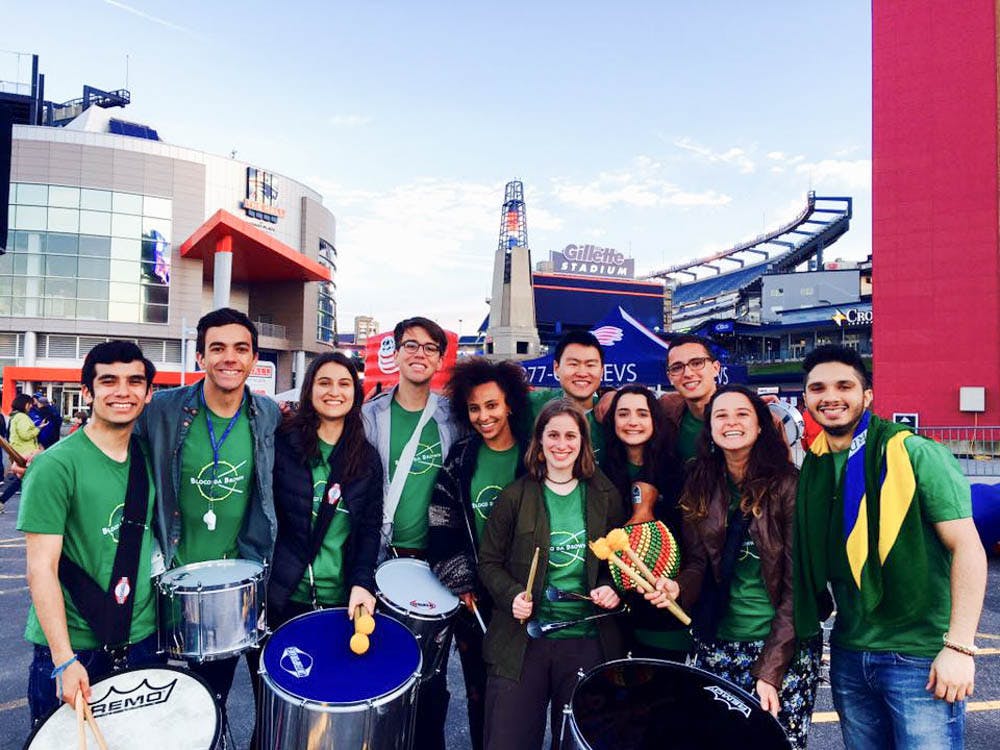Mateus Picanco Lima Gomes ’18 grew up playing music in Brazil. When he was 11, he learned to strum the four-stringed cavaquinho. But as time went on, his interest in traditional Brazilian music waned, and he and his friends became more drawn to the rhythm of rock music. During his first weeks at Brown, he encountered a familiar sound. He heard a pandeiro, a Brazilian tambourine, at the activities fair and followed the sound to a booth. The musician playing the instrument was Maris Jones ’15, who founded Bloco da Brown, an Afro-Brazilian percussion group based on a similar club she had been a part of in high school. Picanco Lima Gomes joined Bloco da Brown and the organization has been integral to his college experience ever since. The club has been his way of “coming back to Brazilian music,” he said.
Carlo Ladd ’17 had a similar introduction to Bloco da Brown. A lifetime musician with an interest in percussion, Ladd decided to join with Picanco Lima Gomes and Jessica Kenny ’17. Today, Ladd leads the percussion group, taking care to ensure it remains a collaborative operation. “You can learn,” Ladd said. “Everyone has a rhythm in them.”
Gabriela de Queiroz Campos ’19 became involved “kind of by accident,” she said. After receiving an email from fellow Brazilian students about Bloco da Brown, she showed up assuming she would attend some kind of performance. “I was handed drums,” she said. “I kept coming because I liked it.” De Queiroz Campos sees the group as “a great way to stay involved with things that are culturally important to me.”
The group has played all around New England and has been featured at gatherings ranging from events hosted by the University’s Department of Portuguese and Brazilian Studies to performances at Harvard for Carnival. Bloco da Brown has even played at Gillette Stadium in Foxborough, Massachusetts, where they hosted Brazilian soccer player Ricardo Izecson dos Santos Leite, affectionately referred to as “Kaká.” Bloco da Brown has gone from jamming at local events to the main stage without compromising their open attitude, according to Ladd. “I don’t know if there’s another group quite like us at Brown,” he said, adding that Bloco is “a culturally-grounded group that still plays concerts for large amounts of people.”
The group plays three core rhythms: samba, maracatu and samba reggae, Kenny said. They also play more popular music, including funk, which is often played at clubs or parties in Brazil. Recently, the group has even taken on some American pop songs to play during some of their collaborations and shows. This helped when they played with the acapella groups Brown’sTones, the Bear Bones and the Chattertocks, which served as an opportunity for Bloco da Brown to develop a space for the interface of Brazilian percussion and pop music. Bloco da Brown combines “a new wave of Brazilian music and old traditional music,” Ladd said.
Ladd arranges the music with help from Picanco Lima Gomes and other members of the group. In keeping with Bloco oral tradition, the group rarely writes anything down. “You do it so many times it gets drilled in your head,” de Queiroz Campos said. “I was going to say you can do it with your eyes closed … (but) of course, it’s drumming,” she added.
“We speak a lot of Portuguese,” Kenny said. “Our goal is to be open and share.”
“I always translate the jokes,” Picanco Lima Gomes added.
Bloco da Brown invites anyone interested, with any level of experience or skill, to join them in making music. “I step in there and I feel at home,” Kenny said.
Correction: A previous version of this article misspelt "pandeiro," a Brazilian tambourine, as "pondeiro." The Herald regrets the error.





